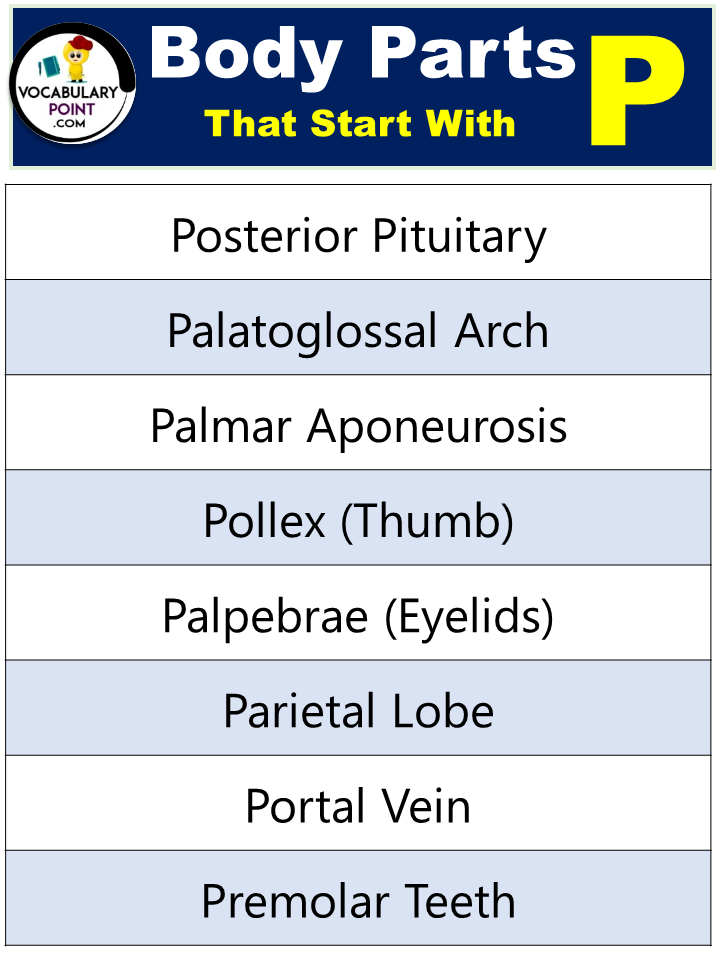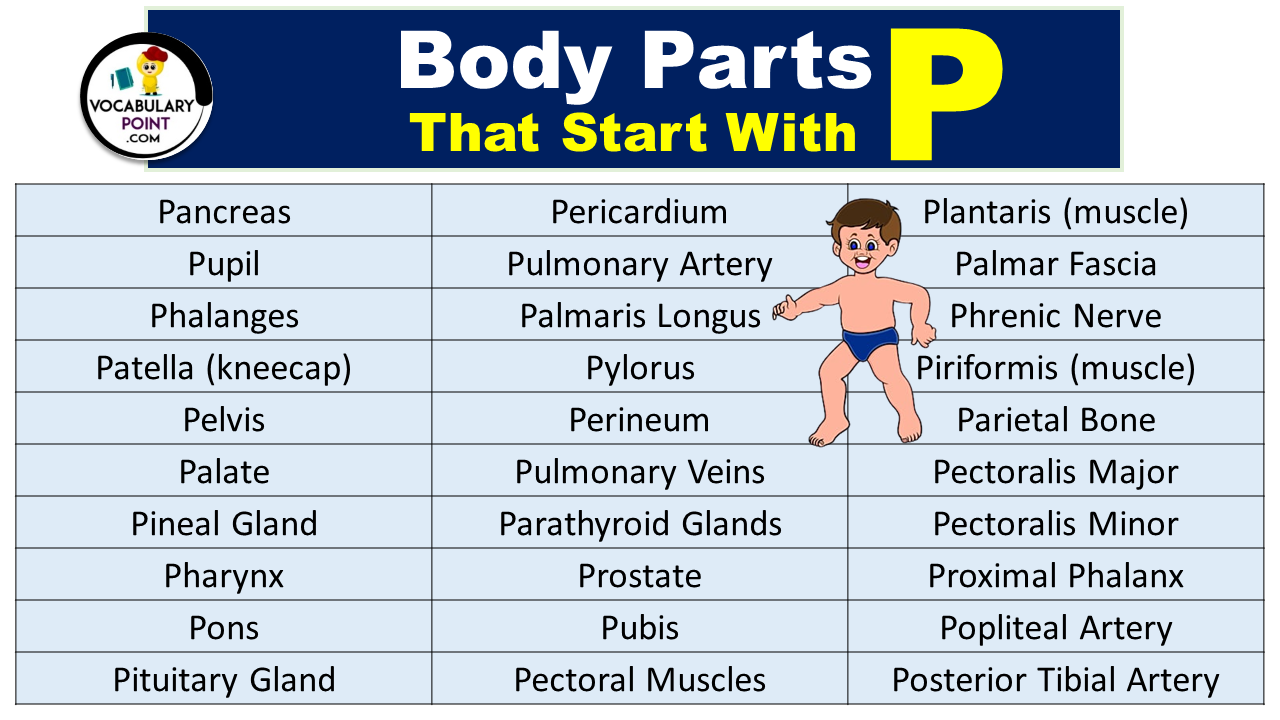The human body, an intricate and sophisticated biological system, is composed of numerous parts, each essential for its harmonious functioning. Among these, are various anatomical components and structures Body parts that start with ‘P’. This compilation offers an insight into the ‘P’ starting elements of our body, emphasizing their unique roles and significance in our physiology.
Body Parts That Start With P
- Pancreas
- Pupil
- Phalanges (finger and toe bones)
- Patella (kneecap)
- Pelvis
- Palate
- Pineal Gland
- Pharynx
- Pons
- Pituitary Gland
- Pericardium
- Pulmonary Artery
- Palmaris Longus (muscle)
- Pylorus (part of the stomach)
- Perineum
- Pulmonary Veins
- Parathyroid Glands
- Prostate
- Pubis (part of the pelvic bone)
- Pectoral Muscles
- Plantaris (muscle)
- Palmar Fascia
- Phrenic Nerve
- Piriformis (muscle)
- Parietal Bone
- Pectoralis Major (chest muscle)
- Pectoralis Minor (chest muscle)
- Proximal Phalanx (finger and toe bones)
- Popliteal Artery
- Posterior Tibial Artery
Explore More:
(A, B, C, D, E, F, G, H, I, J, K, L, M, N, O, P, Q, R, S, T, U, V, W, X, Y, Z)

Body Parts Beginning With P (Their Properties)
- Pancreas – Gland producing digestive enzymes and hormones.
- Pupil – Adjustable opening in the eye controlling light entry.
- Phalanges – Bones in fingers and toes.
- Patella – Kneecap, protects knee joint.
- Pelvis – Bony structure supporting the spine and lower limbs.
- Palate – Roof of the mouth, separating oral and nasal cavities.
- Pineal Gland – Produces melatonin, regulates sleep patterns.
- Pharynx – Throat region, passage for food and air.
- Pons – Part of the brainstem, controls breathing.
- Pituitary Gland – Master endocrine gland controlling hormone release.
- Pericardium – Membrane enclosing the heart.
- Pulmonary Artery – Carries deoxygenated blood from the heart to the lungs.
- Palmaris Longus – Muscle in the forearm influencing wrist movement.
- Pylorus – Lower part of the stomach regulating food passage to the small intestine.
- Perineum – Region between the anus and genitals.
- Pulmonary Veins – Carry oxygenated blood from the lungs to the heart.
- Parathyroid Glands – Regulate calcium levels in the body.
- Prostate – Gland in males producing seminal fluid.
- Pubis – Part of the hip bone.
- Pectoral Muscles – Muscles on the chest.
- Plantaris – Small muscle in the leg, aids in foot flexion.
- Palmar Fascia – Connective tissue in the palm.
- Phrenic Nerve – Stimulates the diaphragm for breathing.
- Piriformis – Muscle in the buttock area, aids in hip rotation.
- Parietal Bone – Forms sides and roof of the skull.
- Pectoralis Major – Large chest muscle, aids in arm movement.
- Pectoralis Minor – Smaller chest muscle beneath the pectoralis major.
- Proximal Phalanx – First set of finger and toe bones.
- Popliteal Artery – Supplies blood to the knee region.
- Posterior Tibial Artery – Supplies blood to the back of the lower leg.
Other Body Parts Starting With The Letter P
- Periosteum
- Palatine Bone
- Proximal Tubule (in kidney)
- Posterior Pituitary
- Palatoglossal Arch
- Palmar Aponeurosis
- Pollex (Thumb)
- Palpebrae (Eyelids)
- Parietal Lobe
- Portal Vein
- Premolar Teeth
- Pancreatic Duct
- Peroneal Artery
- Peroneus Longus (muscle)
- Pudendal Nerve
- Perineal Body
- Plantar Fascia
- Papillae (on the tongue)
- Pectoral Girdle
- Parietal Peritoneum
- Pes Anserinus (conjoined tendons in the knee)
- Parotid Gland
- Phalangeal Joints
- Pelvic Floor Muscles
- Posterior Cerebral Artery
- Pedicles (of vertebrae)
- Pericardial Cavity
- Posterior Cruciate Ligament
- Pinealocytes (cells in the pineal gland)
- Prolactinoma (benign tumor of the pituitary gland)
